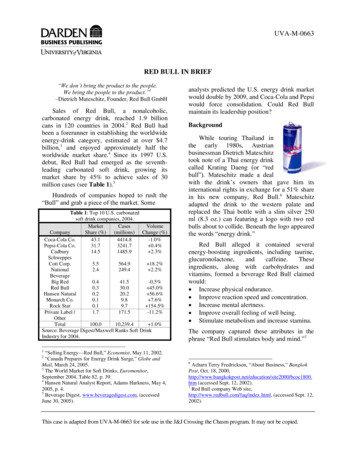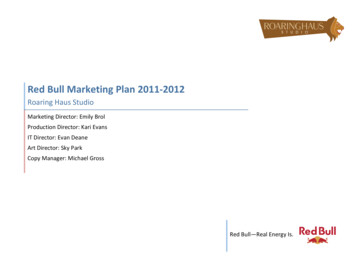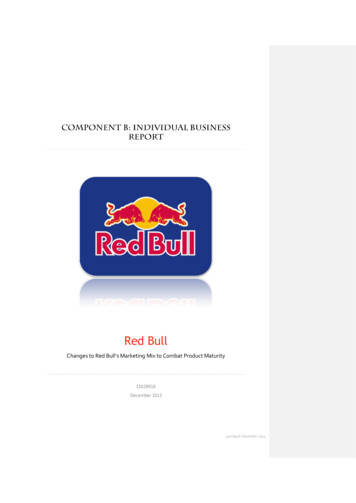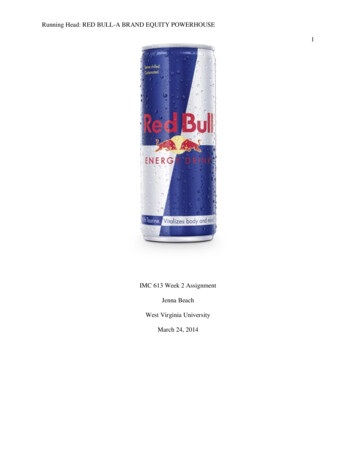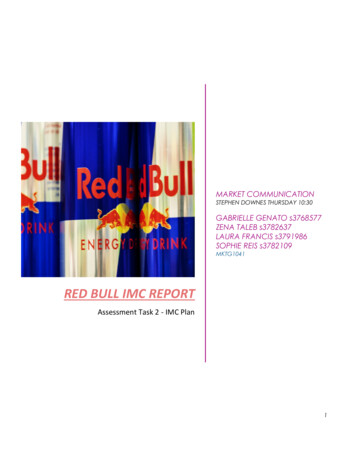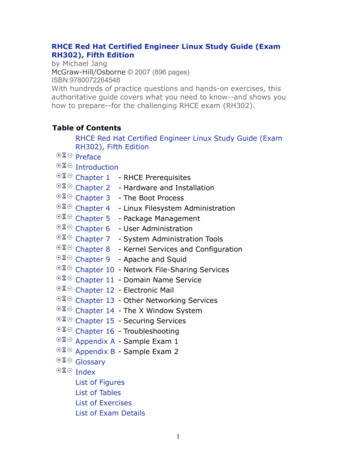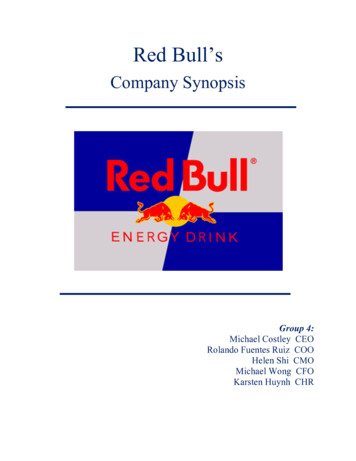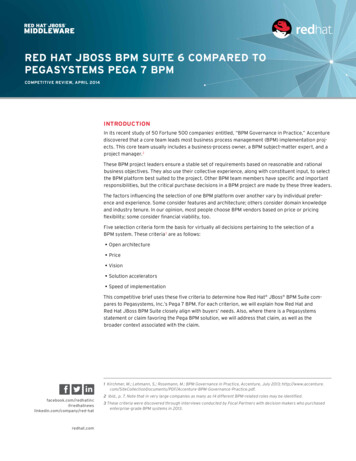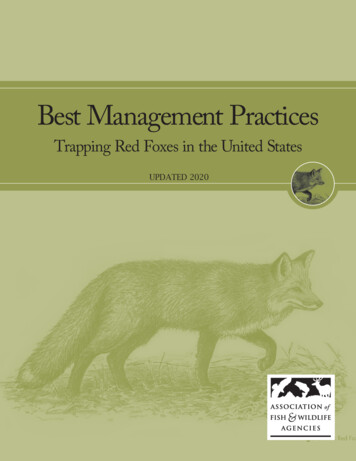
Transcription
Best Management PracticesTrapping Red Foxes in the United StatesUPDATED 2020
Best Management Practices (BMPs) are carefully researched recommendationsdesigned to address animal welfare and increase trappers’ efficiency and selectivity.The extensive research and field-testing used to develop BMPs are described in theintroduction of this manual. The evaluation methods used to develop BMPs have beenstandardized, enabling BMPs to be easily updated and revised as new traps andtechniques become available. All traps listed in the BMP have been tested and meetperformance standards for animal welfare, efficiency, selectivity, practicality, andsafety.Figure RF1. Red fox (Vulpes vulpes)Trapping BMPs provide options, allowing for discretion and decision making in thefield. It does not present a single choice that can or must be applied in all cases. Theyare meant to be implemented in a voluntary and educational approach. BMPs are theproduct of on-going work that may be updated as additional traps are identifiedthrough future scientific testing.The Red Fox at a GlanceCharacteristicsThe red fox is a member of the canine family and is similar in form to a small dog(Figure RF1). Adult red fox are typically 39 to 43 inches in length and weigh from 7 to15 pounds. They have a long bushy tail equal to about 70% of their body length. Redfox display three color phases. The red phase is the most common in North America.Silver phase red fox are much less common and are primarily black, except for a whitetip on the tail and silver frostings on the guard hair tips. Cross phase red fox are darkin coloration with light patches near the legs, shoulders, and hips, giving them a distinctcross pattern of dark fur across the shoulders and back. Red foxes can be distinguishedfrom gray foxes by their white-tipped tail. Silver and cross phases rarely occur south ofCanada. Multiple color phases can occur in the same litter. The scientific name is Vulpesvulpes.RangeRed fox range across most of North America from Alaska and northern Canadasouth to central Texas. They occur from the east coast westward through the RockyMountains, and throughout the Cascade Range in the Pacific Northwest and northern California. They are absent from the southern coastal plain from North Carolinathrough Florida.HabitatRed fox occupy habitats within barren arctic regions, boreal forests, mountainousforest regions as far north as Alaska, agricultural and woodland habitats throughouttheir range, as well as suburban and urban areas. Habitat quality, particularly preyavailability, is a limiting factor for red fox density, but has not limited the distributionof this species.Food HabitsRed foxes are omnivores, consuming animals ranging from insects to small mammals,rabbits and sometimes pets. They commonly take ground-nesting birds and bird eggs,and turtles, frogs, and snakes. Berries and fruits are eaten when available.RED FOX2International Association of Fish and Wildlife Agencies
ReproductionMating occurs from January through March, and generally occurs later in the northernparts of the range. Three to seven pups are born during March through May, about51 to 53 days after breeding. Males and females may remain as breeding pairs forseveral years and work cooperatively to rear offspring. Females may breed prior toone year of age. Pups are weaned at eight weeks of age and typically disperse fromtheir family range during fall. Males typically disperse greater distances than females.PopulationsRed fox usually occupy exclusive areas with little overlap of home range boundaries.Population densities range from one fox per three square miles of habitat to almosteight foxes per square mile in the best habitat. Home ranges in North America rangefrom two to eight square miles, however ranges in excess of 13 square miles havebeen observed in arctic regions.CommentsThe red fox is the most widely distributed carnivore in the world, occurring throughoutNorth America, Europe, Asia, Africa, and Australia. The wide distribution serves astestament to the adaptability of the species, but was also facilitated by introductionsin many areas. Red fox distribution in North America is the combined result of introductions of fox from Europe, which occurred in the late 1700s, and natural expansion ofnative fox populations from the northern latitudes.General Overview of Traps Meeting BMPCriteria for Red Foxes in the United StatesTwo basic types of traps were tested for red foxes: foothold restraining traps and cablerestraints (Table RF2). Examples, brief descriptions, and mechanical details of the variousmakes and models that meet BMP criteria are given in the next section.Table RF2. Overview of traps meeting BMP criteria for red foxes in the United States.Trap CategoryJaw/FrameCharacteristicsInside Jaw/FrameSpread at Dog*Coil-springPadded45/16-5Unmodified4Offset, laminatedand/or wide41/2 7/16Smooth, roundrod, 1/8 inch cable63/8Cable CharacteristicsLoop DiameterLocks6-8 inchesRelaxing locksPoweredCable DeviceNon-powered3/16Inside Width at Jaw/Frame Hinge Posts*47/16-654-45/8 9/16-51/45 1/27/1659/166Cable Device* Inches3Best Management Practices for Trapping in the United StatesRED FOX
Inside widthat jaw hingepostsGeneral Considerations When Trapping Red FoxesInside jaw spreadJaw-type Traps Many currently used trap models meet specifications Pan tension set to two pounds improves selectivity and foot placement in the trap Captures and holds animals alive, allowing for releasePowered Cable Devices (foot capture) Pan-tension set to four pounds improves selectivity Large cable-loop diameter minimizes capture of smaller species Cables require frequent replacement Captures and holds animals alive, allowing for releaseFigure RF3. Coil-spring trapNon-Powered Cable Devices The use of loop stops and breakaway devices can improve selectivity Cables require frequent replacement Captures and holds animals alive, allowing for releaseSpecifications of Traps Meeting BMP Criteriafor Red Foxes in the United StatesAs more capture devices are tested and new information becomes available, they willbe added to an updated list. Mechanical descriptions of tested traps are given as anaid to trappers or manufacturers who may wish to measure, build, or modify traps tomeet these specifications (Figure RF3). Also, other commercially available traps, modified traps, or other capture devices not yet tested may perform as well as, or betterthan the listed BMP traps. References to trap names are provided to identify the specifictraps tested. This list is provided for information purposes only, and does not imply anendorsement of any manufacturer.These are average mechanical measurements which are rounded to the nearest 1/16 inch.There may be up to 1/8 inch variation in specifications on the part of the manufacturer.Manufacturers use recognizable names, such as “No. 2” coil-spring, to identify certaintraps. However, there is no standardized system linking mechanical design features withtrap names. The mechanical features of these traps are listed so that similar traps may beidentified. The performance of anchoring systems was not specifically evaluated. However,methods of attachment are described for informational purposes.Padded Jaws (Figures RF4 - RF7)Average Mechanical Description and AttributesInside jaw spread (at dog): 4 1/2 inchesInner width: 4 7/8 inchesInside width at jaw hinge posts: 4 7/16 inchesJaw width: 9/16 inch padded jawJaw thickness: 3/8 inchMain trap springs: Two 0.130 inch wire-diameter coil springsBase plate: Not reinforcedPadding: Manufacturer supplied rubber padsFigure RF4. Padded jaw trap (open)RED FOX4International Association of Fish and Wildlife Agencies
Any trap that has similar specifications may be considered a BMP trap regardless ofbrand or source of modification, although performance information on all other BMPcriteria (see “Criteria for Evaluation of Trapping Devices”: Introduction pages 4-6)needs to be considered as well. The trap tested was the Woodstream Victor No. 1 1/2Softcatch coil spring (Figure RF4).Additional information Chain attachment used in trap testing: 6 inch, center mounted with one swivel, oneshock spring and anchored with a stake. Selectivity features: Brass pan tension machine screw; pan tension was set to twopounds for testing, and checked and readjusted as needed after every capture. Special considerations for practicality: Some damage to trap pads should be expectedand will require occasional replacement as a normal part of trap maintenance andupkeep. Special care should be taken to prevent odor contamination of the rubberjaws. Avoid using petroleum-based dye directly on the rubber pads. This device alsomeets BMP criteria Arctic fox, for nutria, opossum, and raccoon.Average Mechanical Description and AttributesInside jaw spread (at dog): 4 1/2 inchesInner width: 4 7/8 inchesInside width at jaw hinge posts: 4 9/16 inchesJaw width: 9/16 inch padded jawJaw thickness: 3/8 inchPadding: Manufacturer supplied rubber padsMain trap springs: Two 0.131 inch wire-diameter coil springsAdditional springs: Two 0.100 inch wire-diameter coil springsBase plate: Reinforced with D-ringAny trap that has similar specifications may be considered a BMP trap regardless ofbrand or source of modification, although performance information on all other BMPcriteria (see “Criteria for Evaluation of Trapping Devices”: Introduction pages 4-6)needs to be considered as well. The trap tested was the Woodstream Victor No. 1 1/2Softcatch modified coil-spring, four-coiled (Figures RF5a & RF5b).Figure RF5a. Padded jaw, 4 coiledtrap (open)Additional information Chain attachment used in trap testing: 7 1/2 inch, center mounted with two swivels,one shock spring and anchored with a stake. Selectivity features: Brass pan tension machine screw; pan tension was set to twopounds for testing, and checked and readjusted as needed after every capture. Special considerations for practicality: Some damage to trap pads should be expectedand will require occasional replacement as a normal part of trap maintenance andupkeep. Special care should be taken to prevent odor contamination of the rubberjaws. Avoid using petroleum-based dye directly on the rubber pads. This device alsomeets BMP criteria for bobcat, Eastern coyotes, fisher, and opossum.Figure RF5b. Padded jaw,four-coiled trap (closed)5Best Management Practices for Trapping in the United StatesRED FOX
Average Mechanical Description and AttributesInside jaw spread (at dog): 4 5/16 inchesInner width: 4 1/4 inchesInside width at jaw hinge posts: 4 9/16 inchesJaw width: 1/2 inch smooth round jawJaw thickness: 1/4 inchMain trap springs: Two 0.122 inch wire-diameter springsBase plate: Not reinforcedPadding: Commercially available, post-production rubber padsAny trap that has similar specifications may be considered a BMP trap regardless of brandor source of modification, although performance information on all other BMP criteria (see“Criteria for Evaluation of Trapping Devices”: Introduction pages 4-6) needs to be considered as well. The trap tested was the Woodstream Victor No. 1 1/2 coil-spring trapwith Humane Hold pads (Figure RF6).Figure RF6. Humane Hold padsAdditional information Chain attachment used in trap testing: 6 inch, center mounted with one swivel, oneshock spring and anchored with a stake. Selectivity features: Brass pan tension machine screw; pan tension was set to twopounds for testing, and checked and readjusted as needed after every capture. Special considerations for practicality: Some damage to trap pads should be expectedand will require occasional replacement as a normal part of trap maintenance andupkeep. Special care should be taken to prevent odor contamination of the rubberjaws. Avoid using petroleum-based dye directly on the rubber pads.Average Mechanical Description and AttributesInside jaw spread (at dog): 4 1/2 inchesInner width: 4 5/8 inchesInside width at jaw hinge posts: 5 inchesJaw width: 5/8 inch padded jawJaw thickness: 3/8 inchMain trap springs: Two 0.137 inch wire-diameter coil springsBase plate: Not reinforcedPadding: Manufacturer supplied rubber padsAny trap that has similar specifications may be considered a BMP trap regardless ofbrand or source of modification, although performance information on all other BMP criteria (see “Criteria for Evaluation of Trapping Devices”: Introduction pages 4-6) needsto be considered as well. The trap tested was the BMI No. 2 padded coil-spring.Additional Information Chain attachment used in trap testing: 6 inch, center mounted with one swivel, oneshock spring and anchored with a stake. Selectivity features: Brass pan tension machine screw; pan tension was set to twopounds for testing, and checked and readjusted as needed after every capture. Special considerations for practicality: Some damage to trap pads should be expectedand will require occasional replacement as a normal part of trap maintenance andupkeep. Special care should be taken to prevent odor contamination of the rubberjaws. Avoid using petroleum-based dye directly on the rubber pads.RED FOX6International Association of Fish and Wildlife Agencies
Average Mechanical Description and AttributesInside jaw spread (at dog): 5 3/16 inchesInner width: 6 1/16 inchesInside width at jaw hinge posts: 6 7/16 inchesJaw width: 9/16 inch padded jawJaw thickness: 3/8 inchPadding: Manufacturer supplied rubber padsMain trap springs: Two 0.145 inch wire-diameter coil springsAdditional springs: Two 0.115 inch wire-diameter coil springsBase plate: Reinforced with D-ringAny trap that has similar specifications may be considered a BMP trap regardless ofbrand or source of modification, although performance information on all other BMPcriteria (see “Criteria for Evaluation of Trapping Devices”: Introduction pages 4-6)needs to be considered as well. The trap tested was the Woodstream Victor No. 3Softcatch modified coil-spring, four-coiled (Figrue RF7).Additional information Chain attachment used in trap testing: 18 inch center mounted with three swivels, oneshock spring and anchored with a stake. Selectivity features: Brass pan tension machine screw; pan tension was set to twopounds for testing, and checked and readjusted as needed after every capture. Special considerations for practicality: Some damage to trap pads should be expectedand will require occasional replacement as a normal part of trap maintenance andupkeep. Special care should be taken to prevent odor contamination of the rubberjaws. Avoid using petroleum-based dye directly on the rubber pads. This device alsomeets BMP criteria for Eastern and Western coyotes.Figure RF7. Softcatch,four-coiledUnmodified Jaws (Figures RF8 and RF9)Average Mechanical Description and AttributesInside jaw spread (at dog): 4 1/2 inchesInner width: 4 1/4 inchesInside width at jaw hinge posts: 4 5/8 inchesJaw width: 7/16 inch smooth round jawJaw thickness: 1/8 inchMain trap springs: Two 0.130 inch wire-diameter springsBase plate: Not reinforcedFigure RF8a. Unmodified jawcoil-spring trap (open)Any trap that has similar specifications may be considered a BMP trap regardless of brandor source of modification, although performance information on all other BMP criteria (see“Criteria for Evaluation of Trapping Devices”: Introduction pages 4-6) needs to be considered as well. The trap tested was the Woodstream Victor No. 1 1/2 coil-spring (Figure RF8a &RF8b.Additional information Chain attachment used in trap testing: 9 1/2 inch center mounted with two swivels,one shock spring and anchored with a stake. Selectivity features: Brass pan tension machine screw; pan tension was set to twopounds for testing, and checked and readjusted as needed after every capture. Special considerations for practicality: This device also meets BMP criteria for bobcat.Figure RF8b. Unmodified jawcoil-spring trap (closed)7Best Management Practices for Trapping in the United StatesRED FOX
Average Mechanical Description and AttributesInside jaw spread (at dog): 5 1/4 inchesInner width: 4 9/16 inchesInside width at jaw hinge posts: 5 inchesJaw width: 1/2 inch smooth round jawJaw thickness: 1/8 inchMain trap springs: Two 0.145 inch diameter wire coil springsBase plate: Not reinforcedAny trap that has similar specifications may be considered a BMP trap regardless of brandor source of modification, although performance information on all other BMP criteria (see“Criteria for Evaluation of Trapping Devices”: Introduction pages 4-6) needs to be considered as well. The trap tested was the Woodstream Victor No. 1.75 coil-spring (RF9).Additional Information Chain attachment used in trap testing: 9 1/2 inch center mounted with two swivels,one shock spring and anchored with a stake. Selectivity features: Brass pan tension machine screw; pan tension was set to twopounds for testing, and checked and readjusted as needed after every capture. Special considerations for practicality: This trap also meets BMP criteria for Easternand Western coyotes.Figure RF9. Unmodified jawOffset, Laminated and/or Wide Jaws(Figures RF10- RF14.)Average Mechanical Description and AttributesInside jaw spread (at dog): 4 7/16 inchesInner width: 4 1/4 inchesInside width at jaw hinge posts: 4 9/16 inchesJaw width: 7/16 inchJaw thickness: 1/8 inchJaw thickness with lamination: 5/16 inchLamination: 3/16, above jaw laminationMain trap springs: Two 0.130 inch wire-diameter springsBase plate: Not reinforcedAny trap that has similar specifications may be considered a BMP trap regardless of brandor source of modification, although performance information on all other BMP criteria (see“Criteria for Evaluation of Trapping Devices”: Introduction pages 4-6) needs to be considered as well. The trap tested was the Woodstream Victor No. 1 1/2 modified coil-springtrap, laminated (lamination on top of jaws) (Figure RF10).Figure RF10. Laminated jaw trapAdditional Information Chain attachment used in trap testing: 6 inch, center mounted with one swivel, oneshock spring and anchored with a stake. Selectivity features: Brass pan tension machine screw; pan tension was set to twopounds for testing, and checked and readjusted as needed after every capture. Special considerations for practicality: This trap also meets BMP criteria for grayfoxRED FOX8International Association of Fish and Wildlife Agencies
Average Mechanical Description and AttributesInside jaw spread (at dog): 5 1/16 inchesInner width: 4 9/16 inchesWidth at jaw hinge posts: 5 1/16 inchesJaw width: 7/16 inch smooth round jawJaw thickness: 5/16 inchJaw thickness with lamination: 1/2 inchJaw offset: 3/16 inchLamination: 3/16, above jaw laminationMain trap springs: Two 0.135 inch wire-diameter coil springsBase plate: Not reinforcedAny trap that has similar specifications may be considered a BMP trap regardless of brandor source of modification, although performance information on all other BMP criteria (see“Criteria for Evaluation of Trapping Devices”: Introduction pages 4-6) needs to be considered as well. The trap tested was the Woodstream Victor No. 1.75 coil-spring, modifiedwith offset jaws, laminated (lamination on top of jaws) (Figure RF11).Figure RF11. Laminated offset trapAdditional Information Chain attachment used in trap testing: 9 1/2 inch center mounted with two swivels,one shock spring and anchored with a stake. Selectivity features: Brass pan tension machine screw; pan tension was set to twopounds for testing, and checked and readjusted as needed after every capture. Special considerations for practicality: This device also meets BMP criteria forAmerican badger, bobcat, gray fox, and Eastern and Western coyote.Average Mechanical Description and AttributesInside jaw spread (at dog): 5 1/16 inchesInner width: 4 5/16 inchesInside width at jaw hinge posts: 4 3/4 inchesJaw width: 3/8 inch smooth, oval jawJaw thickness: 1/4 inchJaw offset: 3/16 inchMain trap sprin
ern California. They are absent from the southern coastal plain from North Carolina through Florida. Habitat. Red fox occupy habitats within barren arctic regions, boreal forests, mountainous . forest regions as far north as Alaska, agricultural and woodland habitats thr


